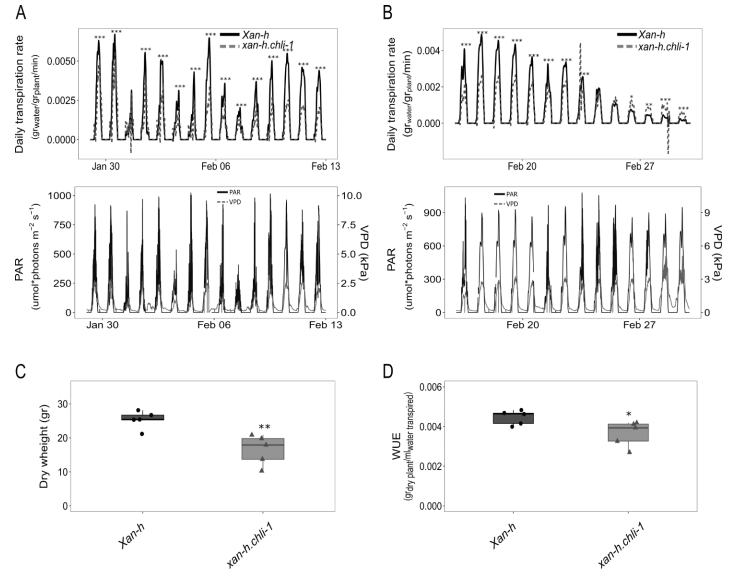品质至上,客户至上,您的满意就是我们的目标
当前位置: 首页 > 新闻动态
科学家利用Plantarray植物功能生理表型测量系统发表大麦表型研究文章
发表时间: 点击:334
来源:北京博普特科技有限公司
分享:
最近,科学家利用Plantarray植物功能生理表型测量系统,发表了题“A missense mutation in the Xan-h gene encoding the Mg-chelatase subunit I leads to a viable pale green line with phenotypic features of potential interest for barley breeding programs”的文章,xan-h.chli-1等位基因变体具有潜在应用价值,可用于定制培育抗逆性大麦和其他作物植物。

编码Mg-螯合酶亚基 I 的 Xan-h 基因的错义突变生成大麦育种所感兴趣的淡绿色品系表型特征
摘要
当高密度培养光合微生物和烟草植物时,淡绿色性状,即叶绿素含量降低,已被证明可以提高光合作用和生物量积累的效率。因此,hus1大麦突变体在光系统天线生物发生方面存在缺陷,并且叶片叶绿素含量降低了50%。然而,它在标准田间条件下的农艺性能与野生型相当。这支持了这样一种观点,即作物可以减少对天线蛋白和叶绿素生物合成的投入,而不会对生产力产生不利影响。在这里,我们评估了通过改变叶绿素生物合成途径(CBP)来降低大麦叶叶绿素含量的影响。为此,我们分离并表征了淡绿色大麦突变体 xan-h.chli-1,该突变体携带 Mg-螯合酶 (HvCHLI) 亚基 I 的 Xan-h 基因错义突变,这是 CBP 中的第一种酶。有趣的是,xan-h.chli-1 是大麦 Xan-h 位点唯一已知的可存活纯合突变体。ATP 结合裂隙中的 Arg298Lys 氨基酸取代导致 HvCHLI 蛋白丰度略有降低,Mg-螯合酶活性显着降低。在受控生长条件下,突变植物表现出天线和光系统核心亚基的积累减少,在中等光照下相对于野生型的光系统II产量降低,并且在高光照强度下始终高于野生型水平。叶片叶绿素含量的降低与日蒸腾速率的稳定降低、总生物量积累和水分利用效率的轻微下降有关。这些性状让人想起在干旱气候条件下茁壮成长的野生大麦种质和地方品种的表型特征。总体而言,我们的研究结果使xan-h.chli-1等位基因变体具有潜在的兴趣,可用于定制大麦和其他作物植物,以便在恶劣环境中生长。
A missense mutation in the Xan-h gene encoding the Mg-chelatase subunit I leads to a viable pale green line with phenotypic features of potential interest for barley breeding programs
Abstract
The pale green trait, i.e. reduced chlorophyll content, has been shown to increase the efficiency of photosynthesis and biomass accumulation when photosynthetic microorganisms and tobacco plants are cultivated at high densities. Thus, the hus1 barley mutant is defective in photosystem antenna biogenesis, and exhibits a 50% reduction in leaf chlorophyll content. Nevertheless, its agronomical performance under standard field conditions is comparable to that of the wild-type. This supports the notion that crops can decrease their investment in antenna proteins and chlorophyll biosynthesis without detrimental effects on productivity. Here, we assess the effects of reducing leaf chlorophyll content in barley by altering the chlorophyll biosynthesis pathway (CBP). To this end, we have isolated and characterised the pale green barley mutant xan-h.chli-1, which carries a missense mutation in the Xan-h gene for subunit I of Mg-chelatase (HvCHLI), the first enzyme in the CBP. Intriguingly, xan-h.chli-1 is the only known viable homozygous mutant at the Xan-h locus in barley. The Arg298Lys amino-acid substitution in the ATP-binding cleft causes a slight decrease in HvCHLI protein abundance, and a marked reduction in Mg-chelatase activity. Under controlled growth conditions, mutant plants display reduced accumulation of antenna and photosystem core subunits, together with reduced photosystem II yield relative to wild type under moderate illumination, and consistently higher than wild-type levels at high light intensities. Moreover, the reduced content of leaf chlorophyll is associated with a stable reduction in daily transpiration rate, and slight decreases in total biomass accumulation and water-use efficiency.These traits are reminiscent of phenotypic features of wild barley accessions and landraces that thrive under arid climatic conditions. Overall, our findings make the xan-h.chli-1 allelic variant of potential interest for tailoring barley, and other crop plants, for growth in harsh environments.